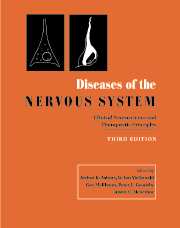Book contents
- Frontmatter
- Dedication
- Contents
- List of contributors
- Editor's preface
- PART I INTRODUCTION AND GENERAL PRINCIPLES
- 1 Pathophysiology of nervous system diseases
- 2 Genetics of common neurological disorders
- 3 Repeat expansion and neurological disease
- 4 Cell birth and cell death in the central nervous system
- 5 Neuroprotection in cerebral ischemia
- 6 Promoting recovery of neurological function
- 7 Measurement of neurological outcomes
- 8 Principles of clinical neuro-epidemiology
- 9 Principles of therapeutics
- 10 Windows on the working brain: functional imaging
- 11 Windows on the working brain: magnetic resonance spectroscopy
- 12 Windows on the working brain: evoked potentials, magnetencephalography and depth recording
- PART II DISORDERS OF HIGHER FUNCTION
- PART III DISORDERS OF MOTOR CONTROL
- PART IV DISORDERS OF THE SPECIAL SENSES
- PART V DISORDERS OF SPINE AND SPINAL CORD
- PART VI DISORDERS OF BODY FUNCTION
- PART VII HEADACHE AND PAIN
- PART VIII NEUROMUSCULAR DISORDERS
- PART IX EPILEPSY
- PART X CEREBROVASCULAR DISORDERS
- PART XI NEOPLASTIC DISORDERS
- PART XII AUTOIMMUNE DISORDERS
- PART XIII DISORDERS OF MYELIN
- PART XIV INFECTIONS
- PART XV TRAUMA AND TOXIC DISORDERS
- PART XVI DEGENERATIVE DISORDERS
- PART XVII NEUROLOGICAL MANIFESTATIONS OF SYSTEMIC CONDITIONS
- Complete two-volume index
- Plate Section
4 - Cell birth and cell death in the central nervous system
from PART I - INTRODUCTION AND GENERAL PRINCIPLES
Published online by Cambridge University Press: 05 August 2016
- Frontmatter
- Dedication
- Contents
- List of contributors
- Editor's preface
- PART I INTRODUCTION AND GENERAL PRINCIPLES
- 1 Pathophysiology of nervous system diseases
- 2 Genetics of common neurological disorders
- 3 Repeat expansion and neurological disease
- 4 Cell birth and cell death in the central nervous system
- 5 Neuroprotection in cerebral ischemia
- 6 Promoting recovery of neurological function
- 7 Measurement of neurological outcomes
- 8 Principles of clinical neuro-epidemiology
- 9 Principles of therapeutics
- 10 Windows on the working brain: functional imaging
- 11 Windows on the working brain: magnetic resonance spectroscopy
- 12 Windows on the working brain: evoked potentials, magnetencephalography and depth recording
- PART II DISORDERS OF HIGHER FUNCTION
- PART III DISORDERS OF MOTOR CONTROL
- PART IV DISORDERS OF THE SPECIAL SENSES
- PART V DISORDERS OF SPINE AND SPINAL CORD
- PART VI DISORDERS OF BODY FUNCTION
- PART VII HEADACHE AND PAIN
- PART VIII NEUROMUSCULAR DISORDERS
- PART IX EPILEPSY
- PART X CEREBROVASCULAR DISORDERS
- PART XI NEOPLASTIC DISORDERS
- PART XII AUTOIMMUNE DISORDERS
- PART XIII DISORDERS OF MYELIN
- PART XIV INFECTIONS
- PART XV TRAUMA AND TOXIC DISORDERS
- PART XVI DEGENERATIVE DISORDERS
- PART XVII NEUROLOGICAL MANIFESTATIONS OF SYSTEMIC CONDITIONS
- Complete two-volume index
- Plate Section
Summary
Formation of the neural tube and control of cell fate by dorsal–ventral signalling centres
One of the most remarkable features of mammalian neural development is the production of the complicated end product, the brain, spinal cord and peripheral nervous system, from a simple one-cell layer thick sheet of neuro-epithelial cells. The first step in this process is the formation and patterning of the neural tube through a process termed neural induction (Kandel et al., 2000). This involves the formation of a specialized region of columnar epithelium, called the neural plate, from the embryonic dorsal ectoderm. Soon after its formation the neural plate folds and becomes a tube (Fig. 4.1). In this process the most medial regions of the neural plate form the ventral neural tube and the more lateral regions of the neural plate form the dorsal neural tube. At the neural plate stage, signals from the mesoderm underlying it pattern the neural plate so that there are molecular differences between the rostral and caudal regions of the neural plate. Therefore, these early patterning events are fundamental to the later production of specialized regions and cells of the nervous system from the neural tube.
Neural induction is not completely understood at the molecular level but significant recent progress has been made (Harland, 2000). Current thinking is that the ectoderm at this stage of embryogenesis has a default neural fate except that the action of bone morphogenetic proteins (BMPs) and Wnts (a family of secreted glycoproteins similar to the wingless gene in Drosophila) expressed widely in the embryo suppress the acquisition of neural fate. Neural induction then occurs in the neural plate because of the release of soluble BMP and Wnt inhibitors from the underlying mesoderm. The inhibition of BMP and Wnt effects allows the default neural fate pathway to operate and the neural plate forms. The rostral–caudal patterning of the neural plate is further affected by the actions of molecules such as retinoic acid (which induces a caudal neural pattern).
After the neural tube forms, the rostral–caudal subdivisions (that will become the telencephalon, diencephalon, mesencephalon, metencephalon and spinal cord) become visible anatomically.
- Type
- Chapter
- Information
- Diseases of the Nervous SystemClinical Neuroscience and Therapeutic Principles, pp. 55 - 61Publisher: Cambridge University PressPrint publication year: 2002

